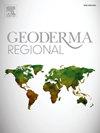Nitrogen mineralization potential depletion in pampas (Argentina) croplands following conversion from native grasslands
IF 3.3
2区 农林科学
Q2 SOIL SCIENCE
引用次数: 0
Abstract
In the Argentinean Pampas, where Phaeozems soils are predominant, the conversion of native grasslands into croplands has negatively affected soil fertility and health. Nitrogen (N) mineralized during an anaerobic incubation (Nan), an estimator of N potential mineralization, is frequently used to evaluate soil health. The objectives of our study were to determine the magnitude of the Nan depletion caused by agriculture (dNan), and to assess the relative contribution of land use, climate, and soil properties on dNan in the Argentinean Pampas. We conducted a soil survey at 409 sites distributed throughout the Argentinean Pampas region. At each site, pairwise samples (0–20 cm) were collected from uncultivated and agricultural soils. At each site, different edaphic, climatic, and productive variables were evaluated. The direct and indirect effect of different variables over dNan was evaluated through a path analysis. The conversion of native grasslands from the Argentinean Pampas into croplands generally decreased Nan values, with Nan reductions ranging from 0 to 216 mg kg−1 (representing 0 to 79 % of the Nan value at uncultivated soils). The magnitude of the Nan depletion was influenced by edaphic variables [i.e. original Nan value (Nan at uncropped soils), soil organic matter depletion, clay content] and climatic variables (i.e. precipitation). These four variables explained 85 % of the dNan variability. From the path analysis, it was determined that soils with greater original Nan values (r = 0.89) and greater soil organic matter depletion (r = 0.65) presented larger dNan, while increases in clay content (r = 0.30) or mean annual precipitation (r = 0.25) resulted in lower dNan values. The identification of the drivers of Nan depletion can aid in the classification of areas with greater vulnerability to soil degradation and in the development of models to predict Nan depletion in soils. Such models would hold significant potential as tools for policymakers and program developers engaged in the formulation and implementation of targeted interventions aimed at halting or reversing this degradation process.
潘帕斯草原(阿根廷)农田从原生草原转化后的氮矿化潜在枯竭
在以Phaeozems土壤为主的阿根廷潘帕斯草原,将原生草原转变为农田对土壤肥力和健康产生了负面影响。厌氧培养(Nan)过程中矿化的氮(N)是氮潜在矿化的估计指标,常用于评价土壤健康。本研究的目的是确定农业引起的南枯竭的程度,并评估阿根廷潘帕斯草原土地利用、气候和土壤性质对南枯竭的相对贡献。我们在阿根廷潘帕斯地区的409个地点进行了土壤调查。在每个地点,从未开垦土壤和农业土壤中成对采集样品(0-20 cm)。在每个站点,评估了不同的地理、气候和生产变量。通过通径分析评估了不同变量对dNan的直接和间接影响。原生草原从阿根廷潘帕斯草原转变为农田一般会降低南值,南值减少幅度为0 ~ 216 mg kg - 1(占未开垦土壤南值的0 ~ 79%)。南耗量的大小受土壤变量(即原始南值(未种植土壤的南值)、土壤有机质耗量、粘土含量)和气候变量(即降水)的影响。这四个变量解释了85%的dNan变异性。通径分析表明,原始Nan值较大(r = 0.89)和土壤有机质耗损较大(r = 0.65)的土壤dNan值较大,而粘土含量增加(r = 0.30)或年平均降水量增加(r = 0.25)导致dNan值较低。确定南枯竭的驱动因素有助于对土壤退化脆弱性较大的地区进行分类,并有助于开发预测土壤南枯竭的模型。这些模型具有巨大的潜力,可以作为政策制定者和项目开发人员制定和实施旨在阻止或扭转这一退化过程的有针对性干预措施的工具。
本文章由计算机程序翻译,如有差异,请以英文原文为准。
求助全文
约1分钟内获得全文
求助全文
来源期刊

Geoderma Regional
Agricultural and Biological Sciences-Soil Science
CiteScore
6.10
自引率
7.30%
发文量
122
审稿时长
76 days
期刊介绍:
Global issues require studies and solutions on national and regional levels. Geoderma Regional focuses on studies that increase understanding and advance our scientific knowledge of soils in all regions of the world. The journal embraces every aspect of soil science and welcomes reviews of regional progress.
 求助内容:
求助内容: 应助结果提醒方式:
应助结果提醒方式:


